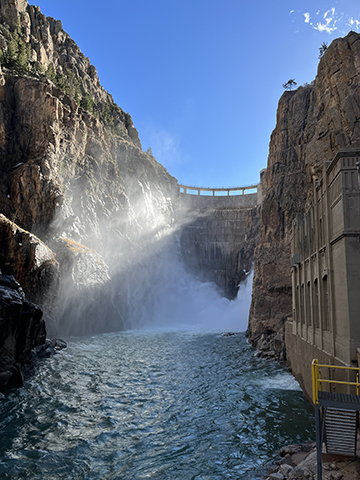 Buffalo Bill Dam
Buffalo Bill Dam
MILLS, Wyo. –– The Bureau of Reclamation, at the request of the Wyoming Game and Fish Department and in coordination with Willwood Workgroup 2, has scheduled a flushing flow in the Shoshone River downstream of Buffalo Bill Dam.
The flushing flow will begin with rapidly increasing flows on April 9 and conclude on April 11. Willwood Irrigation District, in coordination with Willwood Workgroup 2, is planning a controlled elevated release of sediment from Willwood Dam on April 9. The sediment release will pass sediment that has naturally accumulated and is to facilitate operations and maintenance of the diversion structure. The purpose of the increased flows from Buffalo Bill Dam is to help protect the fishery by following the sediment release and mobilizing the sediment downstream. The sediment release and increased flow are being coordinated to minimize impacts to irrigators, recreators, and aquatic life in the Shoshone River.
Reclamation will retime operations and provide the flushing flow with the expectation that excess water will need to be released this spring. The flush will be accomplished without adversely impacting the expected water supply for irrigation.
Flows are expected to fluctuate in the Shoshone River at Cody, Wyoming according to the following schedule:
April 8
- 2:00 a.m. – Increase from approximately 360 cubic feet per second (cfs) to 500 cfs.
- 4:00 a.m. – Increase to 700 cfs.
April 9
- 10:00 a.m. – Increase to 2,000 cfs.
- 12:00 p.m. – Increase to 3,500 cfs.
- 2:00 p.m. – Increase to 5,000 cfs.
- 4:00 p.m. – Decrease to 4,000 cfs.
April 10
- 8:00 a.m. – Decrease to 3,500 cfs.
April 11
- 2:00 p.m. – Decrease to 3,000 cfs.
- 4:00 p.m. – Decrease to 2,500 cfs.
- 6:00 p.m. – Decrease to 2,000 cfs.
- 8:00 p.m. – Decrease to 1,500 cfs.
- 10:00 p.m. – Decrease to 1,250 cfs.
April 12
- 12:00 a.m. – Decrease to 1,000 cfs and maintain until further notice.
The schedule may be modified depending on river conditions.
Flows of 5,000 cfs or more in the Shoshone River below Buffalo Bill Dam are not unusual during peak summer snowmelt runoff periods. But the flows will be high for this time of year, and the public is urged to use extreme caution during this period of flushing flows below Buffalo Bill Dam.
Buffalo Bill Reservoir near Cody, Wyoming, has a storage capacity of 646,565 acre-feet and provides irrigation water to approximately 95,000 acres. It is a source of municipal water supply to multiple communities, and its power generation facilities provide electricity to thousands of homes.

